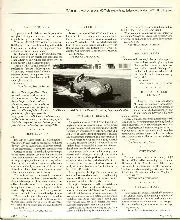
Brussels spouts
SIR, It should be realised that the EU's dictum under which pre-'86 cars could be banned has nothing to do with safety or emissions. It is to do with car…
The greatest British sports car of its era? The greatest sports car, period? There are plenty of voices in both of those camps when it comes to the Jaguar E-type. Even Enzo Ferrari was reputed to have claimed that it was the “most beautiful car ever made”.
No matter where you sit, the Jaguar E-type undoubtedly stopped the show on its Geneva launch in March 1961. Aerodynamicist Malcolm Sayer’s sleek lines around a bang-up-to-date chassis grabbed the headlines, and it boasted figures to match its looks: there was a 0-60mph time of just seven seconds and the promise of 150mph performance from its 3.8-litre straight six, all at a down-to-earth price.
The technology at the heart of the E-type was steeped in Jaguar’s successful racing programme with the D-type of the second half of the 1950s. Like the three-time Le Mans 24 Hours winner, the new road-going sports car had disc brakes at each corner (inboard at the rear), packaged into a steel monocoque chassis with a subframe carrying the engine underneath that outrageously long bonnet, but now the rear featured a sophisticated independent suspension system.
But the Jaguar wasn’t quite the real deal when deliveries of the first fixed-head coupés and open two-seaters began. The new model had been rushed into production, and it wasn’t just the external bonnet catches on the very early cars that suggested the car lacked development. Early E-types were prone to overheating, were under-braked and struggled to accommodate a six-footer.
The bonnet latches were quickly tidied up and a dished footwell introduced to increase cabin space. The E-type remained a work in progress for much of the life of what is now known as the Series 1 car.
“For all their foibles, the earliest cars are the most desirable today”
A torquier 4.2-litre six arrived in 1964, though the unmolested look that had wowed the Geneva crowds three years before remained through to ’68 and the introduction of a revised E-type. The only external difference on the bigger-engined cars was the badging: it now read ‘E-type Jaguar 4.2’ rather than simply ‘Jaguar’. There were plusher seats, and a more comfortable driving experience, and the Moss gearbox gave way to an all-synchro transmission.
A 2+2 version of the FHC came on stream in 1966; it was also the first to be offered as an automatic. There was then a short run of Series ‘one and a half’ cars with the original bumper style, but no headlight cowling thanks to US laws.
Covered headlights, ‘flat floors’ and external bonnet latches are now regarded as badges of honour by E-type owners. It is the earliest, rarest cars that, for all their foibles, are the most desirable today.
A larger ‘mouth’ for improved cooling, wrap-around bumpers to satisfy US rules and new tail lights on the Series 2 somehow dumbed down the lines of the car; the cabin was redesigned, too, and power steering and air-conditioning (LHD only) options offered.
It matters not to the purists of today that the brakes were upgraded and the cooling issues addressed once and for all. For them, the final version of the car is hardly an E-type at all. Powered by a 5.3-litre V12, the Series 3 of 1971 had a wider track and flared wheelarches. The FHC body was dropped and even the 2+2 had been phased out by the end of the car’s life in 1974.
It was a very different motor car to the E-type that had been launched at the start of a decade with which it has become synonymous. And certainly not the most beautiful car ever made.
Price new £2097 (rdstr), £2196 (FHC)
Price now £40-240,000
Engine 3.8-litre, 12-valve, in-line six-cylinder
Power 265bhp
0-60mph 6.9sec
Top speed 150mph
Rivals Jensen C-V8, Aston Martin DB4
Verdict The archetypal British sports car, an icon of the 1960s
Reasons to be careful in your model choice
The Jaguar E-type needs no introduction. However, the creation of the Jaguar Classic programme is an interesting development. This allows individuals to buy an E-type restored by the original manufacturer to as-new condition.
Hence a three-tier E-type market has begun to evolve. Early matching-number cars in poor condition, the building block on which the restorations projects can be based, have had increased demand. Next are restored early vehicles and the third is the more ‘useable’ examples.
Pricing is mostly led by the 500 Series 1 ‘flat floor’ vehicles; one restored by XK Engineering sold in 2016 for £253,500. This January, a 1967 4.2 Roadster restoration project sold for £53,000. In 2018, a LHD 1972 V12 FHC restored 20 years before sold for £34,100, or almost £220,000 less than the ‘flat floor’ above. This suggests it is possible to pick up an older restoration for nearer to half of the newly restored price, often with minimal mileage since completion and surely a good value buy.
The market is voting against LHD and LHD to RHD conversions, which can thus offer a comparatively reasonable entry-point into E-type ownership.
Target deal
Series 1 4.2 Roadster £90 – £110,000, Series 3 V12 FHC £35 – £45,000
Robert Johnson, Classic and Sports Finance
